26th August, 2025
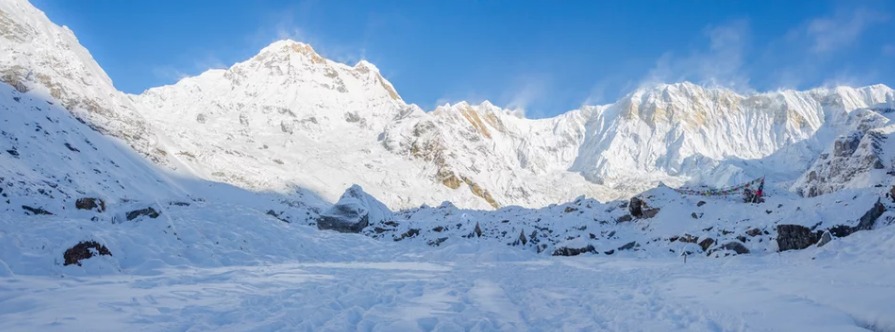
Sep 20, 2023
Annapurna Base Camp Trek In November
- Why Choose November for Trekking?
- Overview of Annapurna Sanctuary and Base Camp
- Route Options and Itinerary Planning
- Weather and Climate Conditions in November
- Preparation and Packing Guide
- Cultural Encounters with Gurung and Magar Communities
- Wildlife and Flora Along the Trail
- Safety Tips and Considerations
- Altitude Sickness: Symptoms and Prevention
- Accommodation Options Along the Trail
- Food and Dining Experiences During the Trek
- Photography Tips for Capturing November Landscapes
- Challenges and Highlights of Trekking in November
- Conclusion
- Annapurna Base Camp Trekking packages
Trekking to Annapurna Base Camp in November offers a profound journey through Nepal's Himalayan wilderness, blending natural beauty with cultural immersion. As November marks the post-monsoon season, trekkers can expect favorable weather conditions characterized by clear skies and crisp air, ideal for capturing stunning mountain vistas.
The trek typically begins from Nayapul or Phedi, winding through diverse landscapes that transition from terraced fields to dense rhododendron forests, which are especially vibrant during this time with blooming flowers in shades of red, pink, and white. These forests provide not only a scenic backdrop but also a habitat for various Himalayan bird species, adding to the trek's allure for nature enthusiasts.
Throughout the journey, trekkers encounter traditional Gurung and Magar villages like Chhomrong and Sinuwa, where local teahouses offer warmth, hospitality, and authentic Nepali meals. This cultural immersion provides insights into the daily lives and customs of these mountain communities, enhancing the trekking experience beyond the natural landscapes.
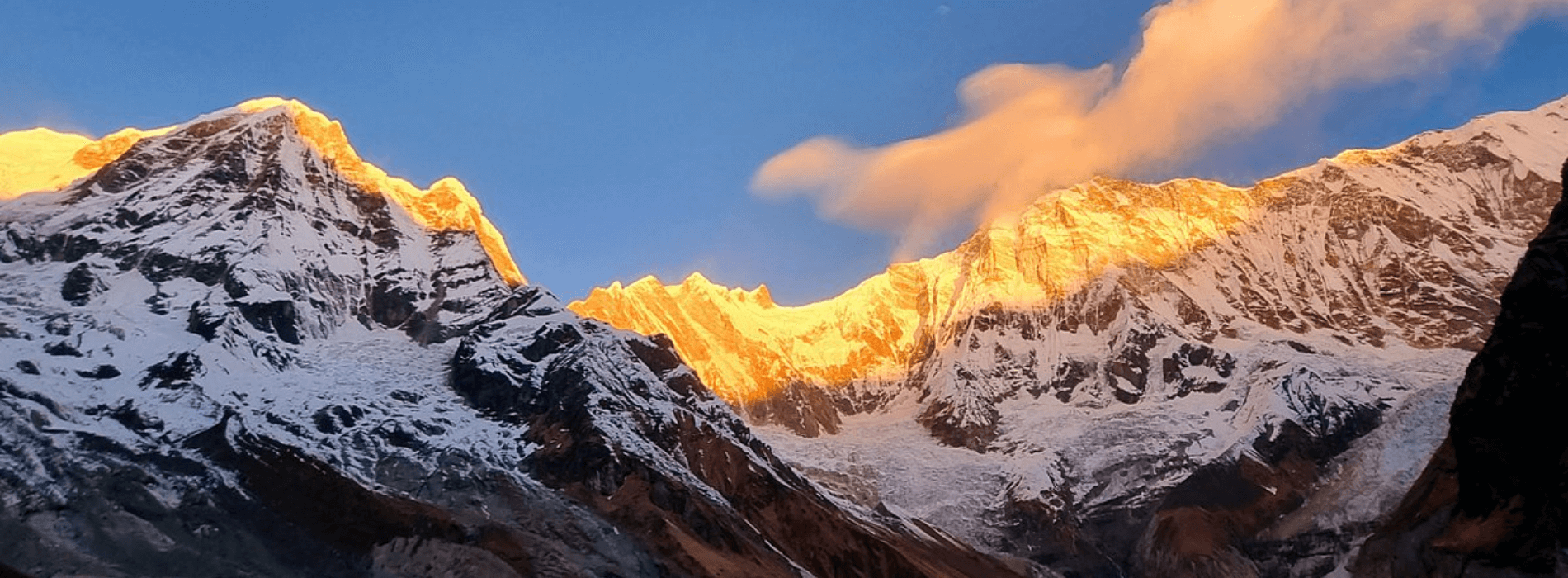
ANNAPURNA BASE CAMP TREK 10 DAYS
This 10 days Annapurna Base Camp (ABC) trek brings you into the heart of Nepal's Himalayas from the very being of the hike. With so many snow-capped peaks on the show, it is no surprise this one-week-...
Ascending higher, the trail opens up to panoramic views of majestic peaks such as Annapurna I, Machapuchare, and Hiunchuli, culminating at Annapurna Base Camp itself. Situated at an altitude of 4,130 meters, the base camp is surrounded by towering mountains and glaciers, creating a dramatic amphitheater of nature's grandeur.
Preparing for the trek involves packing essentials like sturdy hiking boots, warm clothing layers, and a reliable sleeping bag suitable for cold nights. Acclimatization days are crucial for adjusting to higher altitudes, ensuring trekkers stay healthy and enjoy the journey safely.
Overall, trekking to Annapurna Base Camp in November promises a transformative experience, where the challenges of the trail are rewarded with unforgettable moments amidst Nepal's Himalayan splendor.
Why Choose November for Trekking?
November is considered one of the best months for trekking to Annapurna Base Camp due to several compelling reasons. Firstly, it marks the end of the monsoon season in Nepal, ensuring clear skies and minimal rainfall, which significantly enhances visibility and makes for pleasant trekking conditions. The trails are generally less muddy and more stable, offering a safer and more enjoyable experience for trekkers.
Secondly, November boasts moderate temperatures along the trekking route. During the day, temperatures at lower elevations range from 10°C to 15°C (50°F to 59°F), making it comfortable for walking. Nights can be chilly, especially at higher altitudes, but with proper layering, trekkers can stay warm and cozy.
Moreover, November falls within the peak trekking season in Nepal, attracting adventurers from around the world. Despite being popular, the trails are less crowded compared to the preceding months of September and October, allowing for a more serene and immersive trekking experience amidst the breathtaking Himalayan landscapes.

ANNAPURNA BASE CAMP TREK 9 DAYS
The Annapurna Base Camp (ABC) (4130m) is also known as the "Annapurna Sanctuary Trek". This trek promises “in-your-face” unprecedented views of colossal Himalaya ranges, which include Hiunchuli, Macha...
Choosing November for trekking to Annapurna Base Camp ensures optimal weather conditions, stunning mountain views, and a chance to enjoy the trails without the peak-season crowds, making it an ideal time for both seasoned trekkers and first-time adventurers.
Overview of Annapurna Sanctuary and Base Camp
The Annapurna Sanctuary, also known as the Annapurna Base Camp (ABC), is a renowned trekking destination nestled in the heart of the Annapurna Himalayas of Nepal. Situated at an altitude of 4,130 meters (13,549 feet), ABC offers trekkers a unique amphitheater-like setting surrounded by some of the world's highest peaks, including Annapurna I (8,091 meters), the tenth highest mountain globally.
The trek to Annapurna Base Camp begins from Nayapul or Phedi, passing through a diverse range of landscapes that transition from terraced farmlands and lush rhododendron forests to alpine meadows and glacial moraines. Along the way, trekkers encounter traditional Gurung and Magar villages such as Chhomrong and Sinuwa, providing cultural insights and warm hospitality.
The sanctuary itself is a sanctuary of natural beauty, where trekkers are rewarded with panoramic views of towering peaks and pristine glaciers. The base camp area offers a sense of accomplishment and awe as trekkers gaze upon the surrounding peaks bathed in the golden hues of sunrise or sunset.
Overall, the Annapurna Sanctuary and Base Camp trek is a must for adventurers seeking a blend of natural beauty, cultural immersion, and Himalayan grandeur in Nepal.
Route Options and Itinerary Planning
Planning the route and itinerary for the Annapurna Base Camp trek involves choosing from several options that cater to different preferences and fitness levels. Here are popular route options and itinerary planning tips:
- Classic Route via Ghorepani-Poon Hill: This route is favored for its scenic beauty and acclimatization opportunities. It typically takes around 10-12 days, starting from Nayapul, passing through Ghorepani and Poon Hill for sunrise views, and continuing to Annapurna Base Camp.
- Shorter Route via Bamboo: A quicker alternative, this route takes about 7-9 days and is suitable for trekkers with limited time. It follows a direct path from Chhomrong to Bamboo, ascending through the Modi Khola Valley to ABC.
- Mardi Himal Trek Extension: For those seeking a less crowded route, the Mardi Himal extension adds a few extra days to the trek, offering stunning views of Mardi Himal and Machapuchare before joining the main ABC trail near High Camp.
When planning your itinerary, consider factors such as acclimatization days, average trekking hours per day, and overnight stops at teahouses or lodges along the trail. It's essential to be flexible in your planning to accommodate weather conditions and personal fitness levels, ensuring a safe and enjoyable trekking experience to Annapurna Base Camp.
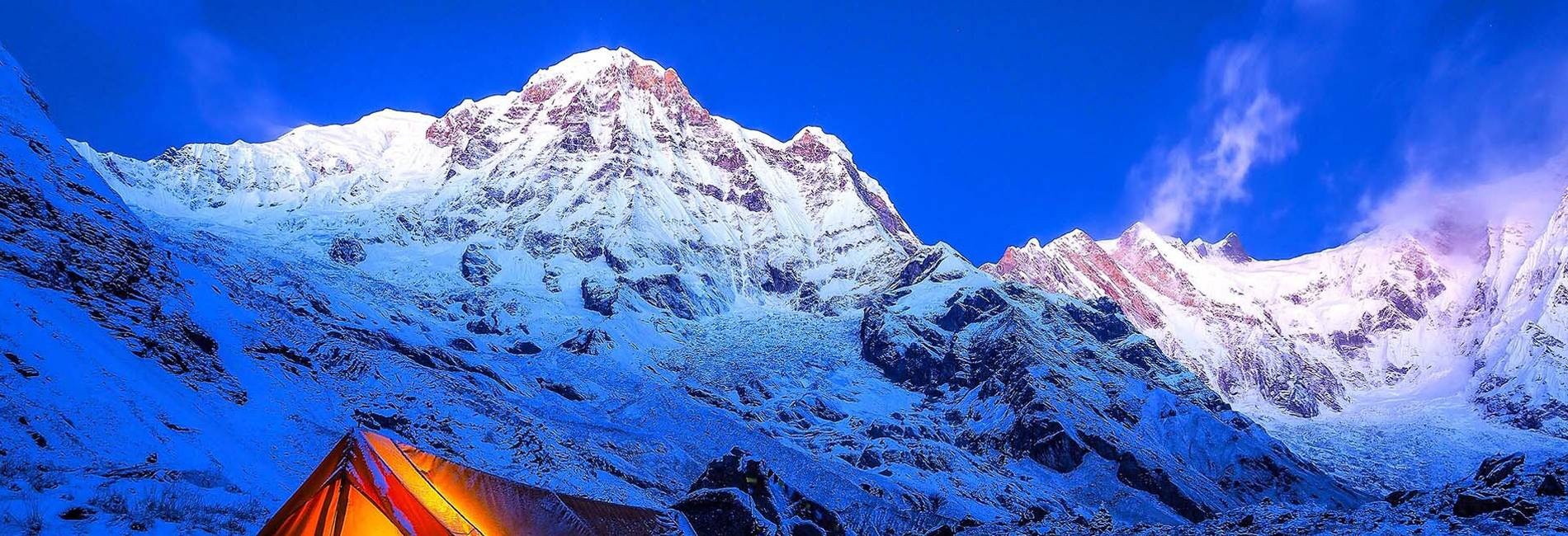
ANNAPURNA BASE CAMP TREK 8 DAYS
The 8 days Annapurna Base Camp Trek is the most popular and amazing trek in the Annapurna region which offers combines remarkable Himalaya vistas, traditional Gurung and Magar village life, and dense...
Weather and Climate Conditions in November
November brings favorable weather conditions to the Annapurna region, making it an excellent time for trekking to Annapurna Base Camp. As the monsoon season recedes, trekkers can expect clear skies, minimal rainfall, and excellent visibility throughout the trekking route.
During November, daytime temperatures at lower elevations range from 10°C to 15°C (50°F to 59°F), providing comfortable trekking conditions. As you ascend to higher altitudes nearing Annapurna Base Camp at 4,130 meters (13,549 feet), temperatures drop, and nights can be chilly. It's essential to pack warm layers, including thermal clothing, a down jacket, gloves, and a hat, to stay comfortable during colder periods, especially early mornings and evenings.
The stable weather conditions in November also enhance the overall trekking experience by offering clear views of the surrounding Himalayan peaks, including Annapurna I (8,091 meters) and Machapuchare (6,993 meters). Trekkers can enjoy breathtaking vistas of snow-capped mountains and rugged landscapes, capturing memorable moments against a backdrop of azure skies and golden sunsets.
When planning your trekking adventure in November, consider checking local weather forecasts and preparing adequately for varying temperature conditions along the trekking route. With favorable weather and stunning scenery, November promises an unforgettable journey to Annapurna Base Camp amidst Nepal's Himalayan splendor.
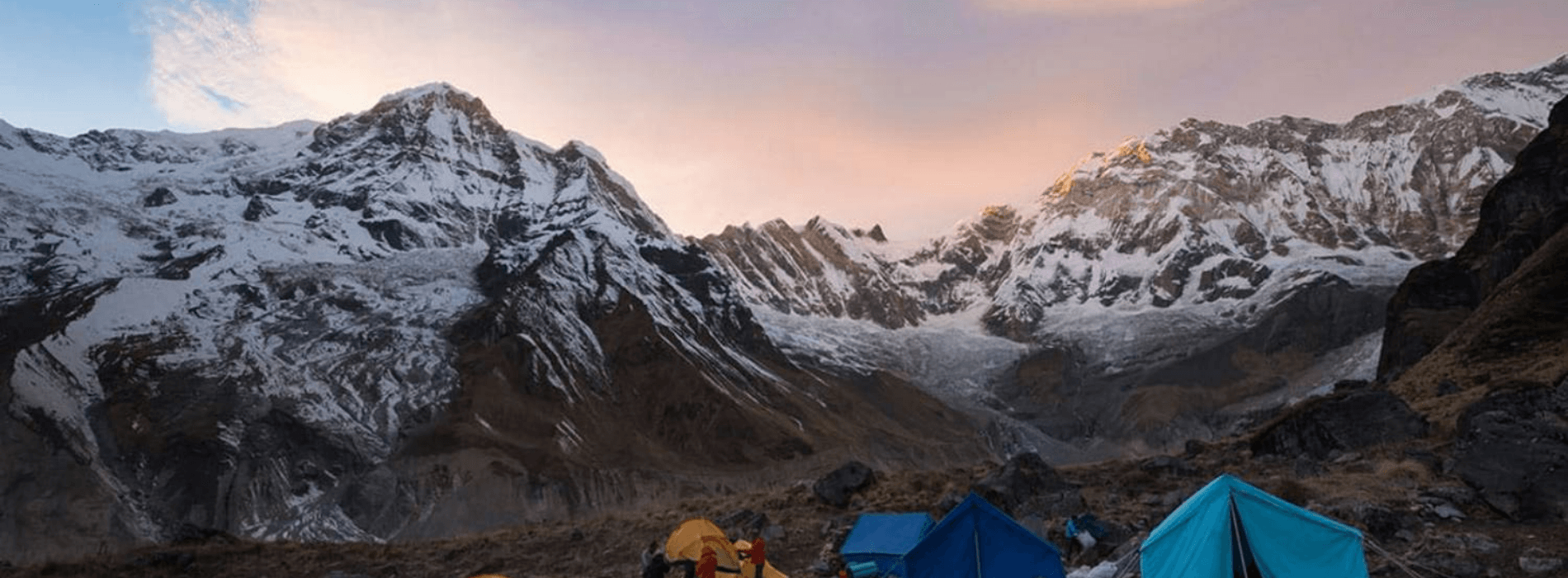
ANNAPURNA BASE CAMP TREK 6 DAYS
The 6 days Annapurna Base Camp Trek is an ideal adventure for those people who have a tight schedule but still want to experience the amazing landscape and the fascinating lifestyles of the Gurung cul...
Preparation and Packing Guide
Preparing for the Annapurna Base Camp trek in November requires careful consideration of essential gear and preparation tips to ensure a safe and enjoyable experience in the Himalayas.
- Clothing: Pack lightweight, moisture-wicking base layers, insulating mid-layers like fleece or down jackets, and a waterproof and windproof outer shell. Include thermal underwear, gloves, a beanie, and sunglasses for protection against cold and sun.
- Footwear: Invest in sturdy, waterproof hiking boots with good ankle support. Break them in before the trek to prevent blisters and ensure comfort during long days of walking.
- Backpack: Choose a comfortable, well-fitted backpack (30-40 liters) with padded straps and a hip belt to distribute weight evenly. Consider a rain cover to protect your gear from unexpected showers.
- Sleeping Bag: Opt for a sleeping bag rated for cold temperatures (0°C to -10°C) to stay warm at higher altitudes. Lightweight and compressible options are ideal for trekking.
- Trekking Poles: Bring trekking poles for stability and to reduce strain on knees and joints during steep ascents and descents.
- Personal Essentials: Pack a headlamp or flashlight with spare batteries, a reusable water bottle or hydration system, sunscreen (SPF 30+), lip balm with SPF, personal toiletries, and a first aid kit with essentials like bandages, blister treatments, and any prescribed medications.
- Electronics: Carry a camera with extra batteries and memory cards to capture stunning landscapes along the trek. A portable charger or solar panel can keep devices powered in remote areas.
Choosing lightweight, durable gear tailored to the November weather conditions ensures you're well-equipped for the challenges and rewards of trekking to Annapurna Base Camp. Prioritize quality and functionality to enhance your trekking experience amidst Nepal's awe-inspiring Himalayan scenery.
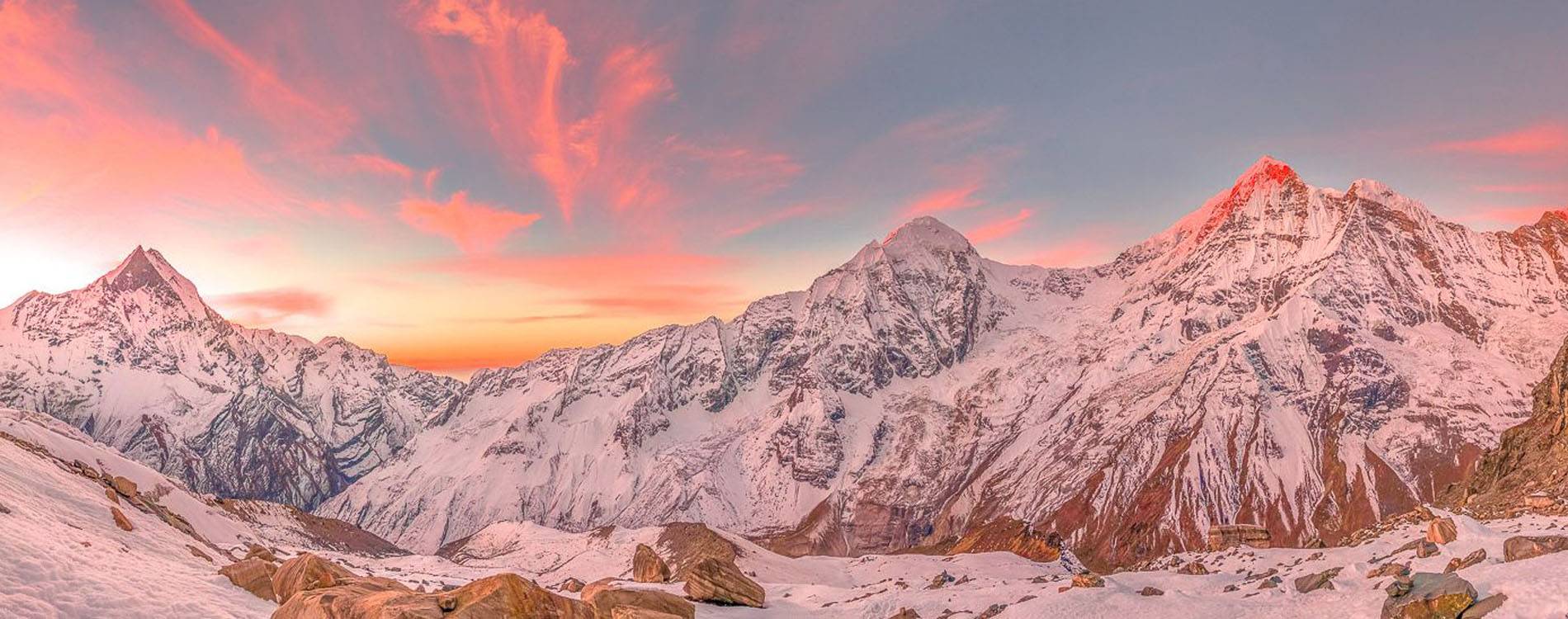
7 DAYS ANNAPURNA BASE CAMP TREK
Short on time – big on beauty!The 7 days Annapurna Base Camp Trek takes you to all the major attractions – but in less time than other treks to the Annapurna region. Take in the spectacular soaring sn...
Cultural Encounters with Gurung and Magar Communities
Trekking to Annapurna Base Camp in November offers a unique opportunity to engage with the Gurung and Magar communities, indigenous to the region. These communities have a rich cultural heritage that includes traditional practices, rituals, and hospitality that add depth to the trekking experience.
The Gurung people, known for their bravery as Gurkha soldiers, and the Magar community, recognized for their agricultural expertise and craftsmanship, welcome trekkers warmly into their villages. Teahouses along the trekking route often run by these communities provide a glimpse into their daily lives. Trekkers can enjoy traditional meals like dal bhat (rice and lentils) and engage in cultural exchanges through dance, song, and storytelling sessions.
Interacting with locals offers insights into their traditions, beliefs, and way of life in the remote Himalayan villages. Respect for local customs, such as removing shoes before entering homes and greeting elders with "Namaste," fosters mutual respect and cultural understanding during the trek.
These encounters not only enrich the trekking experience but also support local economies through tourism, contributing positively to sustainable development in the region.
Wildlife and Flora Along the Trail
The Annapurna Base Camp trek in November provides ample opportunities for wildlife enthusiasts and nature lovers to witness diverse flora and fauna amidst Nepal's Himalayan landscapes.
Flora along the trail varies with altitude, transitioning from lush subtropical forests of rhododendrons, magnolias, and bamboo at lower elevations to alpine meadows adorned with colorful wildflowers like primroses and gentians. November's post-monsoon season enhances the bloom, painting the trail with vibrant hues against the backdrop of snow-capped peaks.
Wildlife sightings include Himalayan birds such as pheasants, eagles, and colorful Himalayan Monal pheasants, which are often seen darting through the forests or soaring above the valleys. Mammals like Himalayan thars, a type of mountain goat known for their agility, and langur monkeys can also be spotted along the trekking route, especially in quieter sections away from human activity.
Respecting wildlife and flora is essential; sticking to marked trails and avoiding disturbing animals or picking flowers helps preserve the natural ecosystem. Trekkers are encouraged to carry binoculars and cameras to capture these natural wonders responsibly, leaving only footprints and taking only memories from their trekking experience in the Annapurna region.
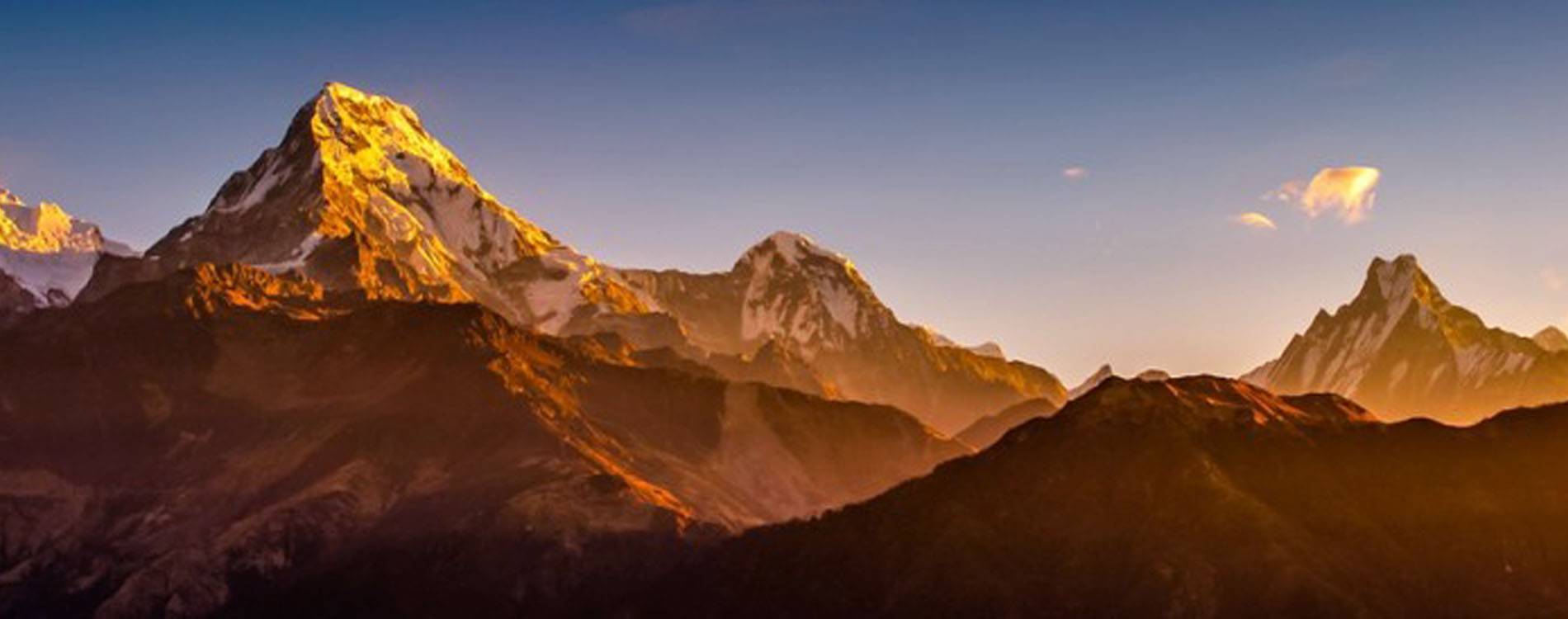
12 DAYS ANNAPURNA BASE CAMP TREK
DOUBLE THE ADVENTURE IN JUST 12 DAYS! The 12 Day Annapurna Base Camp Trek combines two well-known and popular treks into one - the Ghorepani Poon Hill Trek and the Annapurna Base Camp Trek (ABC)....
Safety Tips and Considerations
Trekking to Annapurna Base Camp in November requires careful preparation and adherence to safety guidelines to ensure a safe and enjoyable experience amidst the challenging Himalayan terrain.
- Acclimatization: Schedule rest days for acclimatization to adjust to higher altitudes gradually. Symptoms of altitude sickness, such as headache, nausea, and fatigue, should not be ignored. Descending to lower elevations is necessary if symptoms worsen.
- Weather Awareness: Monitor weather forecasts and be prepared for sudden changes in mountain weather. Dress in layers to adjust to temperature fluctuations and carry waterproof clothing to protect against rain or snow.
- Hydration and Nutrition: Stay hydrated by drinking plenty of water and electrolyte-rich fluids throughout the trek. Carry energy snacks like nuts, dried fruits, and energy bars to maintain energy levels during long days of hiking.
- Trail Safety: Stick to marked trails and avoid shortcuts to minimize the risk of getting lost or encountering unstable terrain. Trekking poles can provide stability on steep ascents and descents.
- Emergency Preparedness: Carry a fully stocked first aid kit with essential medications, bandages, and blister treatments. Familiarize yourself with emergency procedures and communication options in remote areas.
- Travel Insurance: Obtain comprehensive travel insurance that covers trekking activities at high altitudes and includes evacuation in case of emergencies.
By prioritizing safety and following these guidelines, trekkers can navigate the challenges of the Annapurna Base Camp trek in November responsibly, ensuring a memorable and secure journey amidst Nepal's majestic Himalayas.
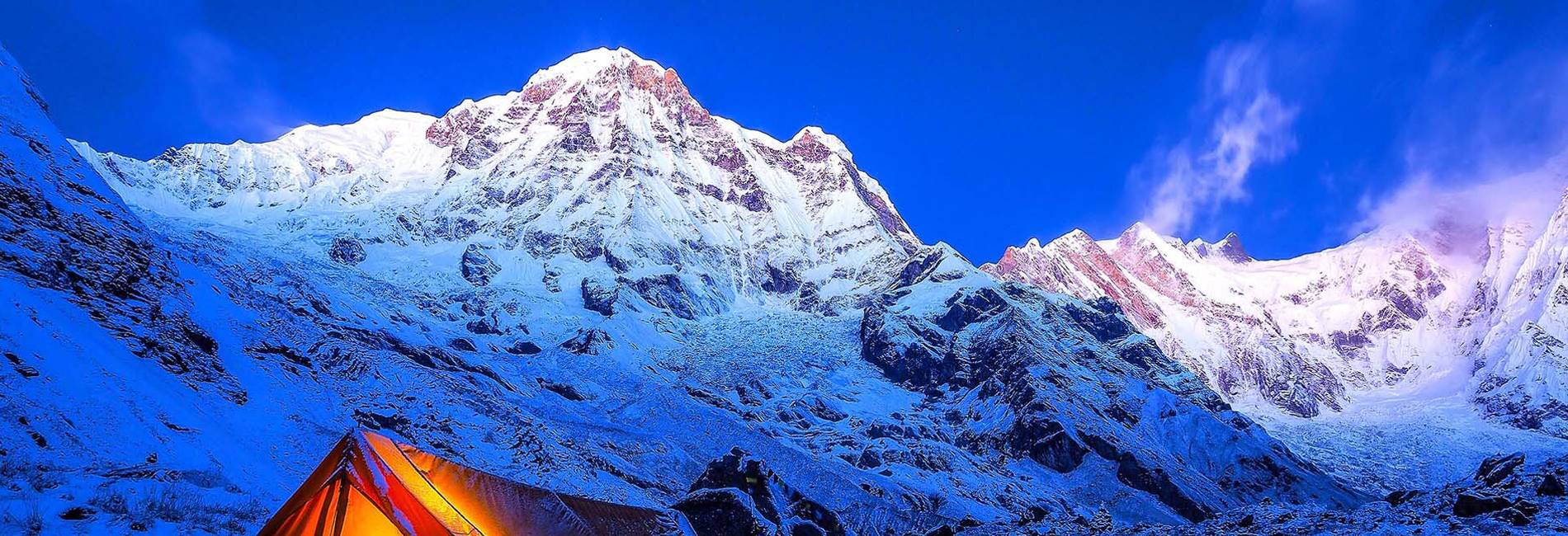
13 DAYS ANNAPURNA BASE CAMP TREK
Discover why “The Annapurna Base Camp (ABC) trek is world-famous. Here is a sample of soaring snow-capped peaks you will see along the trail: Mt. Dhaulagiri (8167m), Mt. Annapurna I (8091m) Mt. M...
Altitude Sickness: Symptoms and Prevention
Altitude sickness, also known as acute mountain sickness (AMS), can affect trekkers ascending to higher altitudes during the Annapurna Base Camp trek in November. It occurs when the body fails to acclimatize to reduced oxygen levels at higher elevations, typically above 2,500 meters (8,200 feet).
- Symptoms: Early signs of altitude sickness include headache, nausea, dizziness, fatigue, and loss of appetite. More severe symptoms may include difficulty sleeping, shortness of breath, and a persistent cough. It's crucial to recognize these symptoms promptly and take appropriate action to prevent further complications.
- Prevention: Several measures can help prevent altitude sickness:
- Gradual Acclimatization: Ascend gradually, allowing time for your body to adjust to higher altitudes. Incorporate rest days into your itinerary to aid acclimatization.
- Stay Hydrated: Drink plenty of fluids, at least 3-4 liters per day, to avoid dehydration, which exacerbates altitude sickness.
- Eat Nutritious Meals: Consume a balanced diet rich in carbohydrates and avoid heavy, fatty foods that may strain digestion at high altitudes.
- Medication: Consider carrying medications like acetazolamide (Diamox) to prevent altitude sickness symptoms. Consult with a healthcare professional before starting any medication.
- Awareness and Monitoring: Be mindful of your physical condition and communicate any symptoms of altitude sickness to your guide or fellow trekkers. Descend immediately if symptoms worsen, as descending to lower altitudes is the most effective treatment for altitude sickness.
Accommodation Options Along the Trail
Accommodation options along the Annapurna Base Camp trek in November cater to a range of preferences and budgets, providing trekkers with comfortable lodgings amidst Nepal's rugged Himalayan terrain.
- Teahouses and Lodges: The most common accommodation choice for trekkers, teahouses (locally known as guesthouses) and lodges are available at regular intervals along the trekking route. These establishments offer basic amenities such as dormitory-style rooms or private rooms with shared bathrooms. Trekkers can enjoy warm hospitality, hearty meals, and a cozy atmosphere after a day of hiking.
- Basic Camping: Some trekkers prefer to carry their camping gear and camp at designated campsites along the trail. This option provides flexibility in choosing overnight locations and allows for a more immersive outdoor experience amidst nature.
- Luxury Lodges: In recent years, luxury lodges have emerged along popular trekking routes like Annapurna Base Camp, offering comfortable accommodations with modern amenities such as hot showers, WiFi, and attached bathrooms. These lodges cater to trekkers seeking a higher level of comfort and convenience during their Himalayan adventure.
Choosing accommodation options depends on personal preferences, budget considerations, and the desired level of comfort and convenience during the trek. It's advisable to book accommodation in advance, especially during the peak trekking season in November, to secure preferred lodging and ensure a pleasant overnight stay amidst the stunning landscapes of the Annapurna region.
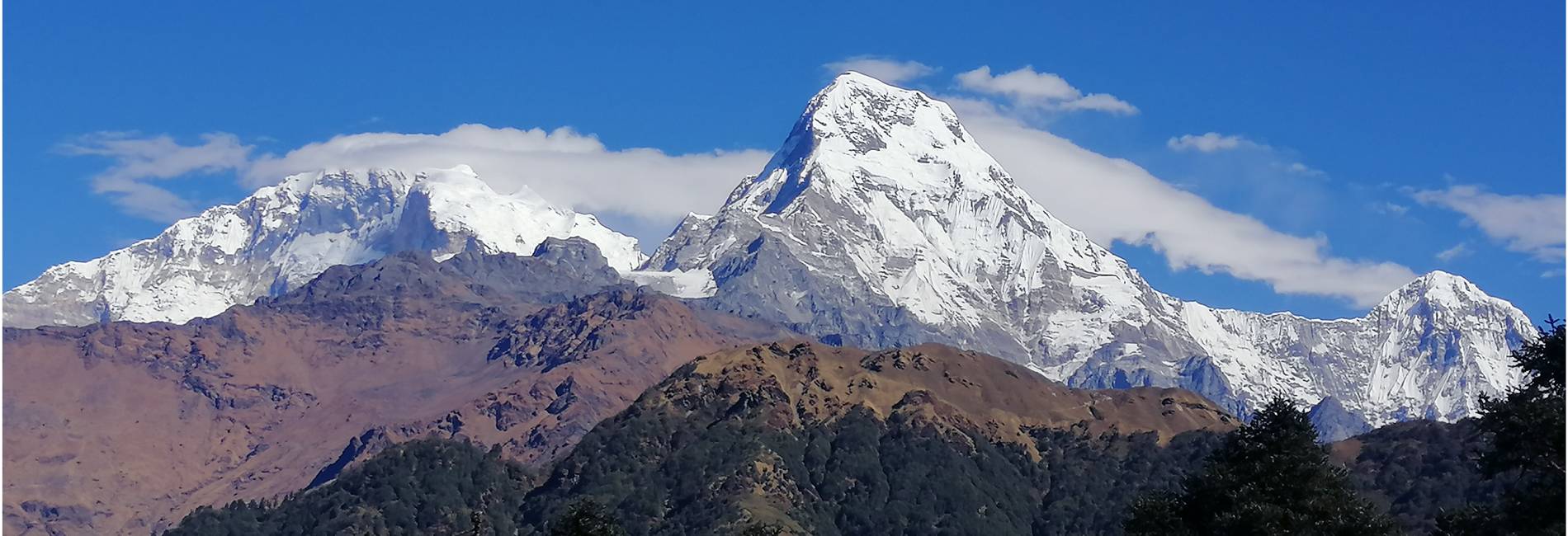
SHORT ANNAPURNA TREK
The Ghorepani Poon Hill Trek, also known as the Annapurna trek or Annapurna C trek, is a captivating journey through the Annapurna region of Nepal, renowned for its natural beauty and cultural richnes...
Food and Dining Experiences During the Trek
Food and dining experiences during the Annapurna Base Camp trek in November offer a delightful blend of local Nepali cuisine and international dishes to cater to trekkers' diverse tastes and dietary needs. Teahouses along the trail serve freshly prepared meals that provide essential energy for trekking in the high-altitude environment.
Traditional Nepali dishes like dal bhat (rice with lentil soup), momos (steamed dumplings), and thukpa (noodle soup) are popular choices among trekkers for their hearty and nutritious qualities. These meals are often accompanied by pickles, vegetables, and occasionally meat, sourced locally to support the mountain communities.
For breakfast, trekkers can enjoy options such as Tibetan bread, pancakes, eggs, and porridge, served with hot tea or coffee to start the day refreshed. Many teahouses also offer western-style dishes like pasta, pizza, and sandwiches, ensuring a variety of culinary experiences throughout the trek.
Vegetarian, vegan, and gluten-free options are available at most teahouses upon request, accommodating dietary preferences and restrictions. It's essential to maintain a balanced diet and stay hydrated by drinking plenty of fluids, including boiled or filtered water provided at teahouses, to sustain energy levels during trekking days.
Overall, dining experiences along the Annapurna Base Camp trek provide trekkers with not only nourishment but also an opportunity to savor the flavors of Nepal amidst the breathtaking Himalayan landscapes.
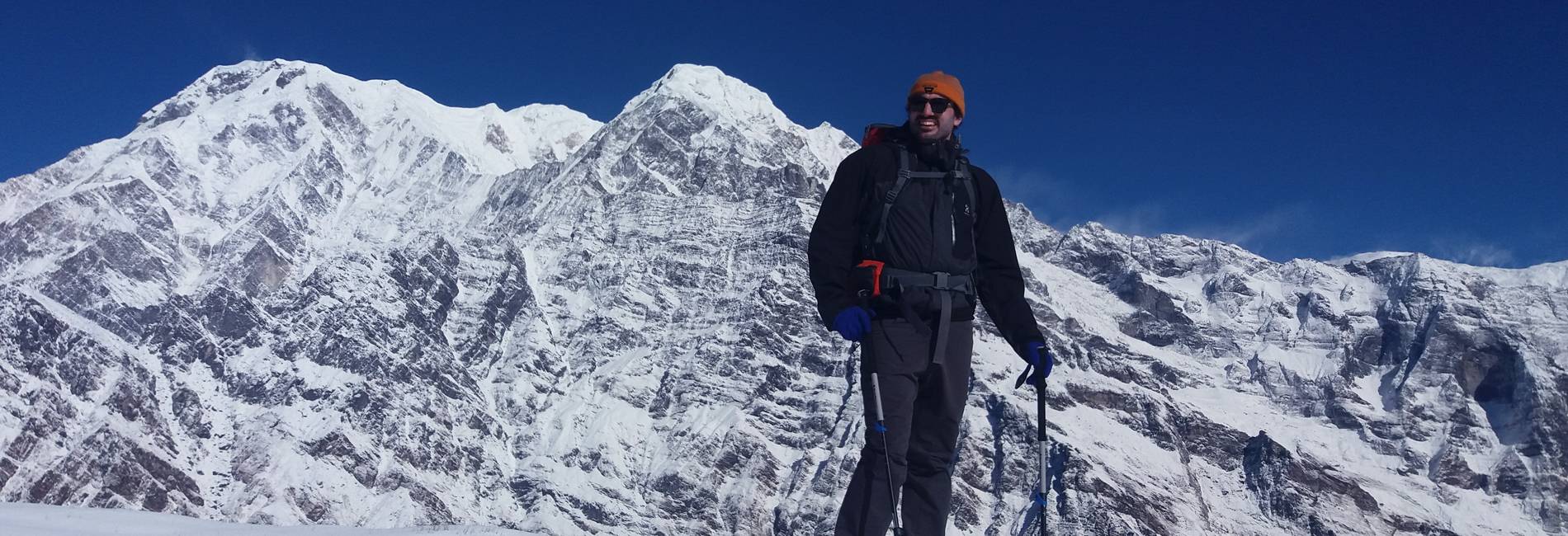
MARDI HIMAL TREK
Enjoy the feeling of solitude as you trek in this remote less traveled region.Fewer tourists, but big on beauty! Snowcapped peaks abound as you enjoy this off-the-beaten-path trek that is full of...
Photography Tips for Capturing November Landscapes
Photographing the stunning landscapes of the Annapurna region in November offers trekkers a chance to capture unforgettable moments amidst Nepal's majestic Himalayan peaks and vibrant natural scenery. Here are some tips for capturing stunning photographs:
- Golden Hour: Make the most of the soft, golden light during sunrise and sunset to capture the mountains bathed in warm hues. The changing light creates dramatic shadows and highlights, enhancing the beauty of the landscape.
- Use Leading Lines: Incorporate trails, rivers, and natural contours as leading lines to draw viewers' eyes into the photograph and create depth.
- Include Foreground Interest: Frame your shot with interesting foreground elements like wildflowers, prayer flags, or local architecture to add depth and context to your photos.
- Capture Cultural Moments: Photograph local villagers, traditional homes, and cultural ceremonies encountered along the trek to document the cultural richness of the region.
- Weather Variations: Be prepared for sudden weather changes in the mountains. Cloud formations, mist, and occasional snowfall can create atmospheric and moody images.
- Wide-Angle and Zoom Lenses: Pack both wide-angle and zoom lenses to capture expansive landscapes as well as close-up details of mountains, flora, and wildlife.
- Stability: Use a tripod or stabilize your camera to ensure sharp images, especially in low light conditions or when capturing long exposures.
- Respect Local Customs: Seek permission before photographing people, especially in villages, and respect local customs regarding photography.
By following these photography tips and embracing the natural beauty of the Annapurna region, trekkers can preserve their trekking memories through captivating photographs that reflect the awe-inspiring landscapes and cultural encounters of their journey.
Challenges and Highlights of Trekking in November
Trekking to Annapurna Base Camp in November presents both challenges and highlights that contribute to a memorable and rewarding Himalayan adventure.
Challenges:
- Temperature Variations: While daytime temperatures at lower altitudes are mild and comfortable, nights at higher elevations can be cold, requiring adequate layers and a warm sleeping bag.
- Altitude Acclimatization: The trek involves gradual ascents to higher altitudes, necessitating acclimatization days to prevent altitude sickness. Trekkers must be mindful of symptoms and descend if necessary.
- Weather Conditions: While November generally offers stable weather with clear skies, occasional precipitation or early snowfall may occur at higher altitudes, affecting trail conditions.
Highlights:
- Panoramic Views: Enjoy breathtaking views of snow-capped Himalayan peaks like Annapurna I, Machapuchare, and Hiunchuli throughout the trek, especially from viewpoints like Poon Hill and Annapurna Base Camp.
- Cultural Immersion: Encounter traditional Gurung and Magar villages, experience warm hospitality at teahouses, and learn about local customs and lifestyles along the trekking route.
- Natural Beauty: Explore diverse landscapes ranging from lush forests of rhododendrons and bamboo to alpine meadows adorned with wildflowers, showcasing Nepal's rich biodiversity.
- Photography Opportunities: Capture stunning sunrise and sunset views, dramatic mountain panoramas, and unique cultural moments to document your trekking adventure.
- Personal Achievement: Reaching Annapurna Base Camp at 4,130 meters (13,549 feet) and standing amidst towering peaks provides a sense of accomplishment and awe-inspiring experience.
Trekking in November offers trekkers a balance of challenges and rewards, from navigating mountain trails and acclimatizing to high altitudes to experiencing Nepal's natural beauty and cultural heritage. By preparing adequately, embracing the journey's highs and lows, and savoring every moment, trekkers can create lasting memories of their adventure in the spectacular Annapurna region.
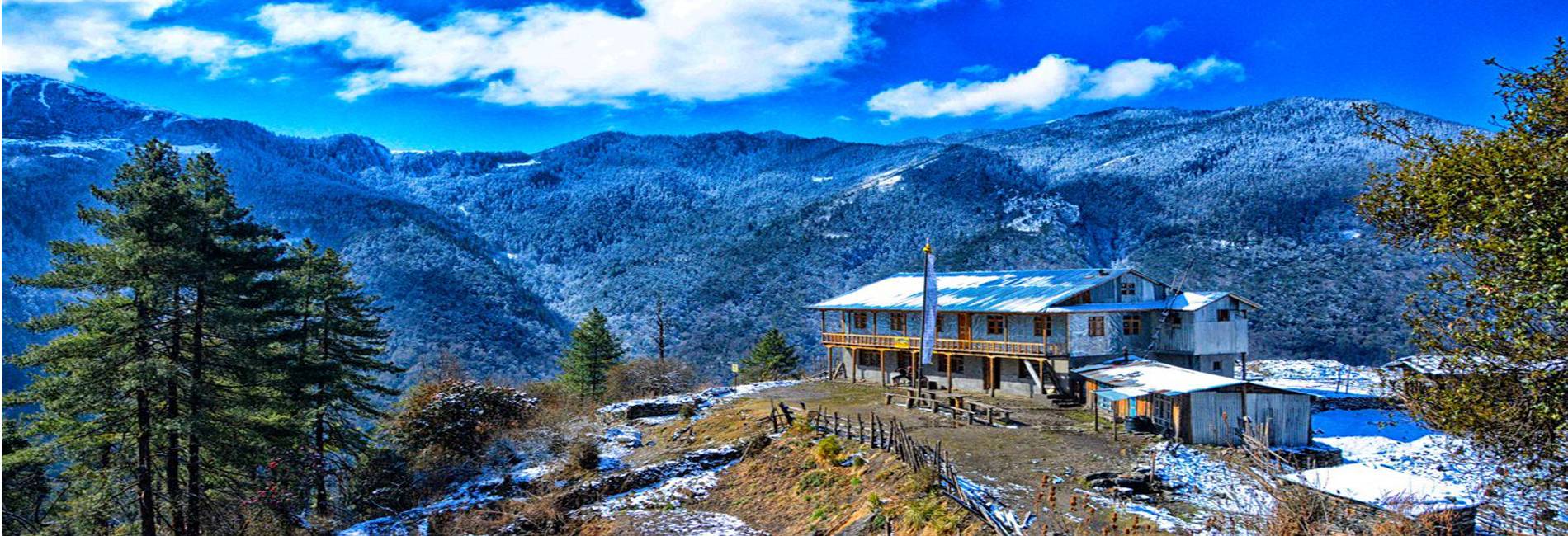
MOHARE DANDA TREK
DON’T LIKE CROWDS – TRY THIS NEW ECO-TOURISM TREK.The Mohare Danda (3313m) Trek is a new destination where trekkers stay in community-owned lodges or homestay. This gives you a more intimate experienc...
Conclusion
Trekking to Annapurna Base Camp in November promises an unforgettable adventure amidst Nepal's Himalayan splendor. From panoramic mountain views and cultural encounters with local communities to diverse flora, fauna, and delicious dining experiences, November offers ideal weather conditions and fewer crowds compared to peak months.
Whether you're a seasoned trekker or embarking on your first Himalayan adventure, November provides an excellent opportunity to explore the natural and cultural wonders of the Annapurna region. Embrace the challenges and highlights of the trek, capture stunning photographs, and cherish the camaraderie shared with fellow trekkers and local villagers along the trail.
Ultimately, trekking to Annapurna Base Camp in November is more than a physical journey; it's a journey of self-discovery, cultural immersion, and appreciation for the majestic landscapes that define Nepal's Himalayas.
Annapurna Base Camp Trekking packages
14 Days Annapurna Base Camp Trek
13 Days Annapurna Base Camp Trek
12 Days Annapurna Base Camp Trek
9 Days Annapurna Base Camp Trek
7 Days Annapurna Base Camp Trek
6 Days Annapurna Base Camp Trek
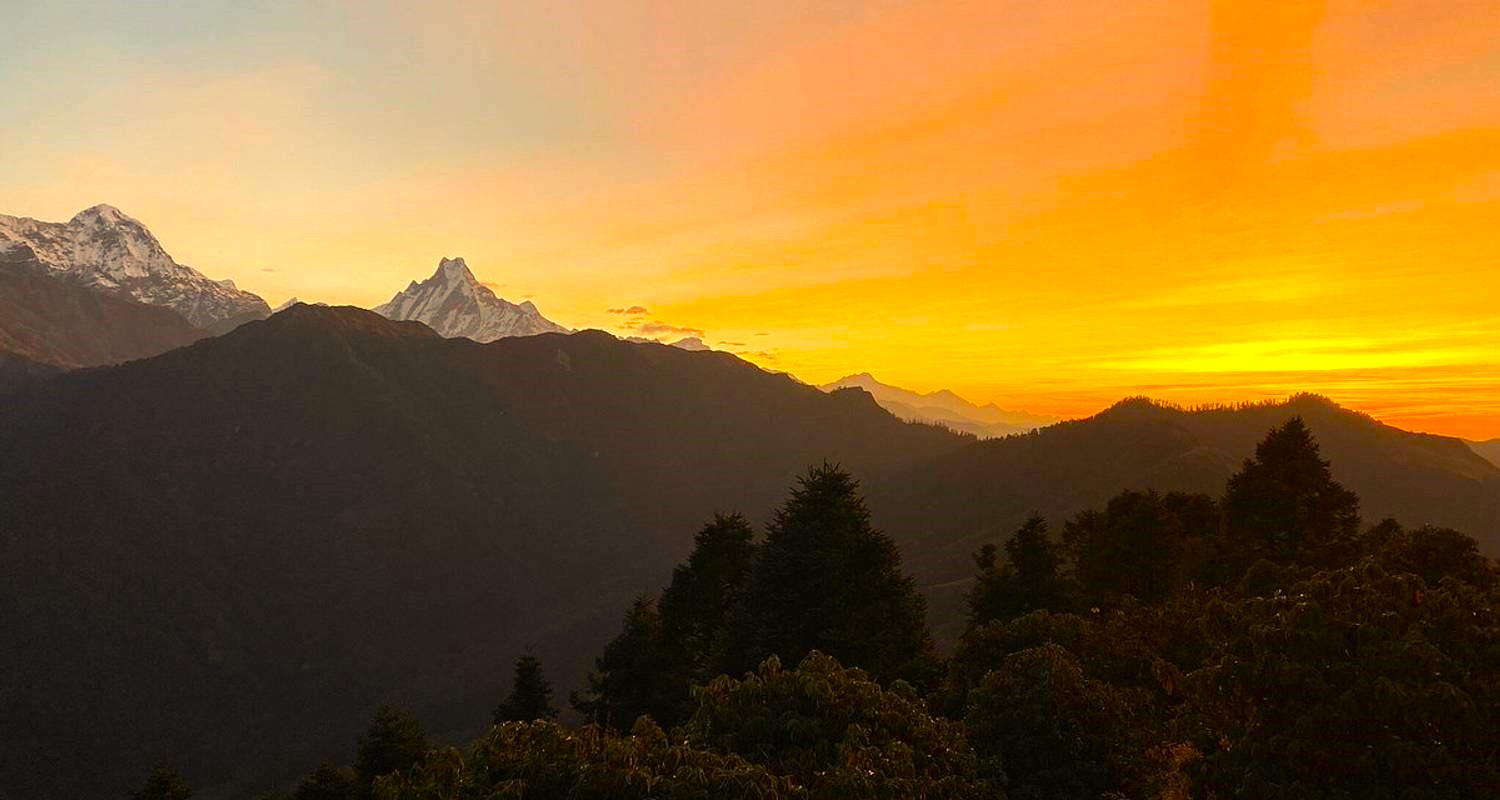
KHOPRA DANDA TREK 6 DAYS
The Khopra Ridge Khayer Lake trek is one of least explored trekking regions in Nepal. It is located to the south of the Annapurna Ranges and is often compared with the Ghorepani Poon Hill trek. Mt. Kh...
Any Questions? Let Us Know.
Recent Posts
17th June, 2025


















